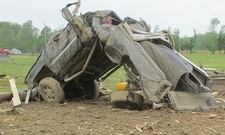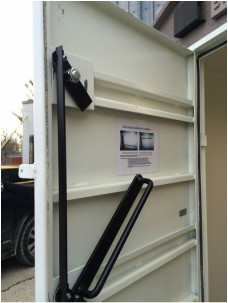|
Although above ground storm shelters have become more popular and widely accepted over the past 10-15 years, we still get this question a few times a month. A small percentage of folks living in tornado-prone areas still believe that the only way to survive an EF5 tornado is by sheltering below ground.
But scientific research has proven that properly engineered and built above ground storm shelters are more than capable of standing up to 250 mph winds to save lives. In some parts of the country, below ground shelters aren't an option due to high water tables and rocky substrates. For other above ground shelter customers, it's a matter of being physically unable to climb down steps in the face of an emergency. For others, it's a fear of being buried alive or being trapped by debris after the storm has passed. This video presentation cites research and reasons why an above ground storm shelter can not only save your life, but may be the best possible choice for you and your family.
To learn more about how Safe Sheds concrete storm shelters are made and get custom pricing, drop us an e-mail orrequest a quote. We'd love to tell you more about how our above ground shelters save lives!
0 Comments
 This is the pickup that struck the Safe Shed storm shelter door in April of 2014. This is the pickup that struck the Safe Shed storm shelter door in April of 2014. It's a common myth that a steel "storm door" with three deadbolt locks is good enough for a storm shelter. It is not. When a "storm door" like this goes through debris testing, it fails every time. It fails by tearing off the hinges, by collapsing when being struck by debris, and by breaking and bending around the deadbolt locks. And a door that fails when hit by debris makes the entire storm shelter virtually useless. In April of 2014, a Safe Shed storm shelter door was struck by an airborne pickup truck that was slammed against it by an EF4 tornado with winds of over 200 mph. The back axle, wheel, and bed of the pickup hit the center of the door between the two top locks. Although there is a small indentation left, the door held firm and all seven people sheltering inside survived with no injuries. Had that same pickup truck struck a home-improvement-store "storm door" with added deadbolts, the truck would have been thrown into the storm shelter, severely injuring the people inside. A piece of wood, much smaller and lighter than a pickup truck, was driven into this type of door during a tornado in Arkansas and killed someone. The door failed, was propelled into the storm shelter, and struck the woman hiding inside, killing her instantly. So what's the takeaway? Your storm shelter must have a tested and approved door, specially designed for storm shelter use. It must have heavy duty hardware, multiple locks, and a reinforced door frame. If you're interested in learning more about the door we use at Safe Sheds, Inc., please feel free to give us a call. Our testing results are also published on our web site. Some people are great at packing for vacation. They make a list, lay everything out neatly, and know how to fold their clothes to minimize wrinkles. Other folks (like me) are horrible at packing, choosing to shove one of everything they own into a suitcase at the last minute. Then, on the second day of vacation, they realize they totally forgot their underwear or toothbrush (I've forgotten both)!
But packing for disaster is serious business and shouldn't be left until the last minute or, worse, ignored in the hope that a disaster kit won't be needed. So, how do you go about packing your family's disaster supply kit? Here are some important tips provided by Ready.gov: 1) Take stock of the most likely disasters or emergencies your family is likely to face and choose your supplies accordingly. Spring emergencies, such as tornadoes, will require some different supplies than winter emergencies, such as ice storms. 2) Understand that a disaster that destroys your home might cover enough territory to render first responders unable to reach you for several hours or even a day or two. Ready.gov and FEMA recommend that your family be self-sufficient for 72 hours. 3) Water is critical. Store one gallon of water per person per day for at least three days to be used for drinking and sanitation. Healthy people can go much longer without food than without water. Don't cut corners here! 4) Stock a three day supply of non-perishable food items such as granola bars, jerky, canned fruit and vegetables (but don't forget the can opener), and peanut butter. Put some disposable paper plates, napkins, and plastic silverware in with your food supplies. 5) Purchase a high-quality battery-powered or hand crank NOAA weather radio. Good radios aren't too expensive and may be your only source of information after a disaster if cell towers go down or are overloaded. 6) Grab a 5 gallon plastic bucket and add a flashlight, extra batteries, a first aid kit, an emergency whistle, dust masks, rubber gloves, duct tape, a tarp, some moist towelettes, garbage bags, and cell phone chargers that run on solar power or are pre-charged. 7) If someone in your family is dependent upon medications, make sure to have a safe supply of their prescriptions on hand. And, if your sheltering with your family's pets, pack a three day supply of water and food for them, too. Consider adding a pet first aid kit in case they're injured by leftover debris after the disaster passes. In addition to gathering your survival supplies, practice responding to emergencies with your family. If you're awoken in the middle of the night by tornado sirens, everyone will respond better and more quickly if they've practiced their responses before the disaster strikes. Want to learn more about being prepared and protecting your family? Visit www.ready.gov for important information, tips, and checklists. |
AuthorMembers of the Safe Sheds team contribute posts from time-to-time. Archives
November 2017
Categories |
We always welcome your visit
1003 South Maple Street
Salem, Illinois 62881 Monday - Friday, 8:00 a.m. - 4:30 p.m. CST 888-556-1531 (toll free) 618-740-0044 (local) [email protected] |
Contact UsSubscribe |


 RSS Feed
RSS Feed
